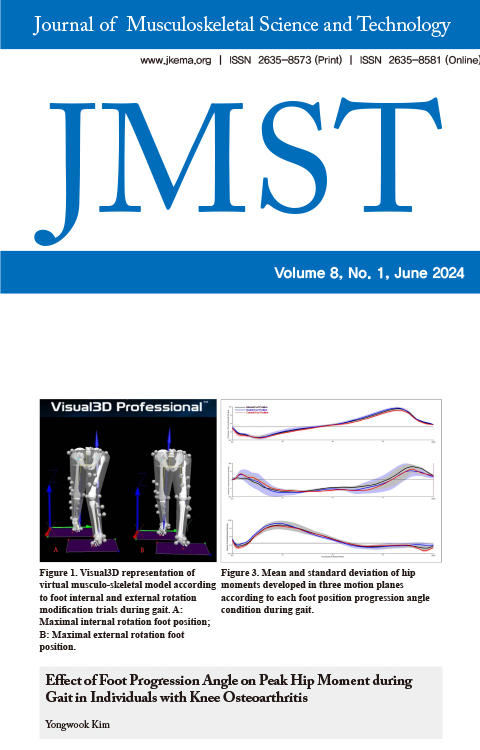Effect of Trunk Posture on Peak Systolic Flow Velocity, Pulsatility Index, and Rate of Perceived Exertion of Common Carotid Artery during Recumbent Cycle Exercise
- KEMA학회
- Journal of Musculoskeletal Science and Technology
- 제8권 제1호
-
2024.0614 - 20 (7 pages)
-
DOI : 10.29273/jmst.2024.8.1.14
- 6

Background The way the body is positioned during recumbent cycle exercise has a significant impact on exercise performance. This type of exercise not only improves cardiovascular endurance but also strengthens the lower limbs. Purpose This study aimed to investigate the impact of body posture during recumbent cycle exercise on the Peak Systolic Flow Velocity (PSV), Pulsatility Index (PI), and rate of perceived exertion (Borg scale) of the common carotid artery. Study design A pre-post cross-sectional design Methods The participants comprised 15 adults without a history of hyperlipidemia or coronary artery disease, who had not previously engaged in recumbent cycle exercise (mean age 22.9±2.0). Doppler ultrasonography was utilized to measure PSV and PI. Data analysis involved one-way repeated measures ANOVA (p<0.05), with post-hoc testing conducted using Bonferroni post hoc analysis (α=0.017). Results Three distinct body postures were assumed during the recumbent cycle exercise: sitting at a hip joint angle of 100° (100° Trunk posture; TP), leaning against the backrest at a hip joint angle of 130° (130° TP), and leaning against the backrest at a hip joint angle of 160° (160° TP). Statistically significant differences were observed in the mean values of PSV and Borg scale among the three postures (p<0.05), while no significant difference was noted in the mean PI values (p=0.533). Bonferroni post hoc analysis indicated significant differences in PSV between 100° TP and 160° TP (p=0.001) and between 130° TP and 160° TP (p=0.001), with no significant difference between 100° TP and 130° TP (p=0.729). Borg scale demonstrated significant differ-ences between 100° TP and 160° TP (p=0.001) and between 130° TP and 160° TP (p=0.001), but no significant difference between 100° TP and 130° TP (p=0.626). Conclusions In conclusion, recumbent cycle exercise to enhance cerebral blood flow is recom mended in the order of 160° TP, followed by 130° TP.
INTRODUCTION
METHODS
RESULTS
DISCUSSION
CONCLUSIONS
REFERENCES
(0)
(0)